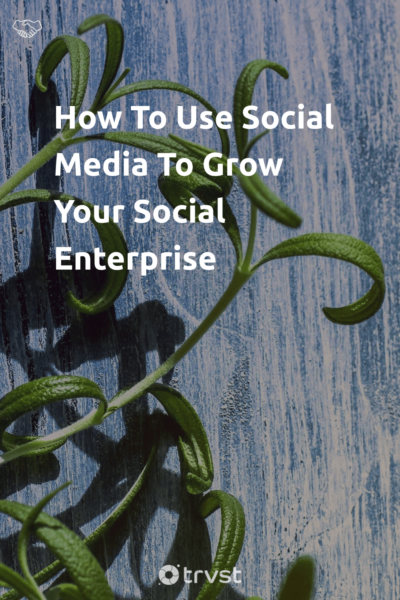How To Use Social Media To Grow Your Social Enterprise
Social media marketing has become an essential marketing tool for most organizations over the last decade. Social media now reaches more people, faster and in more ways in our day-to-day lives than previous mainstream advertising such as television. In fact, while people over 65s still cite TV as their main source of news according to Ofcom, this falls with age until a whopping 82% of 16-to-24-year-olds cite social media as their main news source.
In addition, European consumers in 2019 wouldn’t care if 81% of brands were to disappear overnight, according to Havas Group’s Meaningful Brands 2019 report. This report is wide-reaching based on 1,800 brands and 350,000 respondents across 31 countries. The brands that people do care about are the ones that provide meaningful content, focus on improving their customers' lives, and whom they perceive to be doing good.
Brands that made the top 10 are the ones being transparent and committed to social good. Interestingly, that top 10 list included Gillette, who suffered a bit of backlash from some quarters at the start of the year following their ‘We Believe’ advertising campaign, which focused on countering male bullying and toxic masculinity. However, this has actually played in their favor, with the advert going viral and triggering a fierce social media discussion that included some men (especially older and more traditional males) threatening to boycott Gillette (figures suggest they didn’t) and Millennials celebrating them for stepping into the political void left by out-of-touch governments.
As Pankaj Bhalla, the North American brand director for Gillette, says:
“I think it is important to stand for more than the product’s benefit that you provide, and I think that’s the expectation of our younger audiences.”
So how can you harness this trend for your social enterprise?
As a social enterprise, you already have a head start, which you can and should make the most of. Social media offers you a wonderful platform on which to connect with followers to build a tribe of supporters and customers and show them that you are not just an expert, but a leader in every sense of the word.
Obviously, this is not without its challenges, as increased transparency and taking a lead can sometimes spark pushback in an increasingly polarised world, as Gillette and Greggs have both found recently, and it is why many brands are a bit frightened to use social media properly. Alongside all the good that can be done with social media, there is also the potential that a crisis can quickly turn into a firestorm (we are talking hours not days) if it is not nipped in the bud. Therefore a critical part of ensuring brand trust and reputation is having a crisis management plan in place, and that it is prepped for and practiced frequently so that if the worst does happen it can be extinguished before it escalates.
While the worst social media upsets are very visible and can often be very damaging, most can be dealt with easily enough so long as you have all your ducks in a row and are properly prepared. By being prepared obviously I mean you have a good social media crisis strategy and plan in place, but also that the team has created a robust social media presence to support the brand and you have spent the effort to build a good reputation on all levels (i.e. by treating your staff and suppliers properly, being ethical, etc).
How do you use social media to grow your social enterprise?
- Be authentic. As a social enterprise, you are literally making a promise to improve society. To do that you have to lead, you can’t make promises and then fail to follow through. Social media is the mirror of this, do remember it is just people being social online. In essence, that means you mustn’t shy away from talking about the things that matter or just sit on the fence.
- Be the expert. Do provide the answers to the things that are challenging your audience. If you can do it in an attractive, entertaining and memorable way, so much the better.
- Be transparent and don’t ever use spin - that is so 2000. Do shout about what you are great at, do state your aims & goals, and do stick to your principles. Your tribe i.e. your customers will then be attracted to you and your brand will become memorable.
- Be honest. Remember no one wants to be ignored, fobbed off or lied to. Be totally honest about what you are trying to achieve and how you are doing it. For example, don’t try and make out you’re 100% ethical if you aren’t. The nature of social media means that not only will people notice, but they will make the effort to check and then publically call you out if you have lied, as Iceland found out to their cost following their Christmas advert and palm oil claims.
- Be consistent. Make sure your brand is consistent at every touch point and that the messaging is clear. Don’t risk your reputation with a slow (or no) response on social media, allowing rogue posts a la Ryanair or having a disconnected brand message between social media platforms or social and your website or adverts.
- Become visible. No business can grow if it stays invisible and this is what will happen you use social media as a standalone channel for broadcasting your press releases or chasing empty likes using memes. Using social media as part of an integrated marketing strategy is the best way to increase visibility so people become aware of you and can find you.
- Build your email list. Use social media marketing and advertising to drive visitors to your website, highlight your event, and build your email list.
- Understand your audience. Use it to research your customer’s wants and needs so you can align your products and services to match and so ensure you are providing them with what they need. Understand their pain points, what inspires them, what they struggle with so you can provide the answers and help make their lives easier - and ultimately become their go-to when they decide to buy.
- Use it to improve your SEO and help get your website to the first page of Google for the right terms, which given 93% of all purchases start with online search and only 25% of people click through to the second page, is the place to be if you are looking to grow.
In summary, social media is a fabulous way to build growth for a social enterprise on every level. However, to make it work properly requires strategy, planning, scheduling, and analysis. But is worth the time and investment? Definitely.
Claire Burdett is the co-founder and director of The Media Marketing Co, an integrated agency specializing in social media marketing and getting brands visible and on the first page of Google.

Photo by Rami Al-zayat on Unsplash

